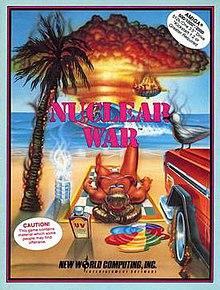Nuclear War (video game)
| Nuclear War | |
|---|---|
 | |
| Developer(s) | New World Computing |
| Publisher(s) | U.S. Gold |
| Designer(s) |
|
| Artist(s) | Avril Harrison |
| Platform(s) | Amiga, MS-DOS |
| Release | 1989 |
| Genre(s) | Turn-based strategy |
| Mode(s) | Single player |
Nuclear War is a single player turn-based strategy game developed by New World Computing and released for the Amiga in 1989 and later for MS-DOS. It presents a satirical, cartoonish nuclear battle between five world powers, in which the winner is whoever retains some population when everyone else on earth is dead.
Gameplay
[edit]The game's introduction includes an homage to Dr. Strangelove. Each player - one human, four computer-controlled - is represented by a caricature of a national leader (the MS-DOS version allowed more than one human player). If there is a computer-controlled winner at the end of the game, that leader is depicted jumping for joy in the middle of a blasted wasteland, crowing "I won! I won!". If the player wins only the high score board is shown. Once a player (computer or human) loses, all of their stockpiled weapons are automatically launched. It is possible for a game to have no winner because of this. If this happens, a cut scene of the earth shattering and exploding is shown, and the high score table appears (though without any new entries).
Characters
[edit]The following characters are available in the game; the public figure being satirized is listed in parentheses.
- Ronnie Raygun (Ronald Reagan)
- P.M. Satcher (Margaret Thatcher)
- Infidel Castro (Fidel Castro)
- Col. Malomar Khadaffy (Muammar al-Gaddafi)
- Ayatollah Kookamamie (Ruhollah Khomeini)
- Mao the Pun (Mao Zedong)
- Jimi Farmer (Jimmy Carter)
- Tricky Dick (Richard Nixon)
- Mikhail Gorabachef (Mikhail Gorbachev)
- Ghanji (Mahatma Gandhi)
Reception
[edit]In the July 1990 edition of Games International (Issue 16), Brian Walker didn't think this was a particularly challenging game, commenting, "All good clean fun with nothing to stretch the brain cells." He concluded by giving the game a rating of 7 out of 10 for gameplay and 8 out of 10 for graphics, saying, "What lifts the game above average is the omnipresent humour."[1]
In the July 1990 edition of Dragon (Issue #159), Hartley, Patricia, and Kirk Lesser characterized the game as "challenging", despite its tongue in cheek humour. However, they were disappointed that only one player could play the game at a time. Nevertheless, they gave the game an above-average rating of 41⁄2 out of 5.[2]
In the October 1990 edition of Computer Gaming World, Chuck Moss favorably reviewed the game's graphics, fast and brief game play, and humorous computer opponents.[3]
Surveys of opinions about wargames with modern settings conducted for Computer Gaming World in 1992 and 1994 awarded the game a rating of 31⁄2 out of 5.[4][5]
See also
[edit]References
[edit]- ^ Walker, Brian (July 1990). "Computer Games". Games International. No. 16. p. 40.
- ^ Lesser, Hartley; Lesser, Patricia; Lesser, Kirk (July 1990). "The Role of Computers". Dragon (159): 47–53.
- ^ Moss, Chuck (October 1990). "Itsy-Bitsy Teeny-Weeny 20-Megaton Bikini". Computer Gaming World. No. 75. p. 36. Retrieved 16 November 2013.
- ^ Brooks, M. Evan (June 1992). "The Modern Games: 1950 - 2000". Computer Gaming World. p. 120. Retrieved 24 November 2013.
- ^ Brooks, M. Evan (January 1994). "War In Our Time / A Survey Of Wargames From 1950-2000". Computer Gaming World. pp. 194–212.
External links
[edit]- Nuclear War at MobyGames
- Reviews at Amiga Reviews
- LemonAmiga docs, comprehensive introduction and guide
- 1989 video games
- Amiga games
- Cold War video games
- Cultural depictions of Fidel Castro
- Cultural depictions of Mahatma Gandhi
- Cultural depictions of Mao Zedong
- Cultural depictions of Margaret Thatcher
- Cultural depictions of Mikhail Gorbachev
- Cultural depictions of Muammar Gaddafi
- Cultural depictions of Richard Nixon
- Cultural depictions of Ronald Reagan
- Cultural depictions of Ruhollah Khomeini
- DOS games
- New World Computing games
- Political satire video games
- Single-player video games
- Turn-based strategy video games
- Video games about nuclear war and weapons
- Video games developed in the United States
